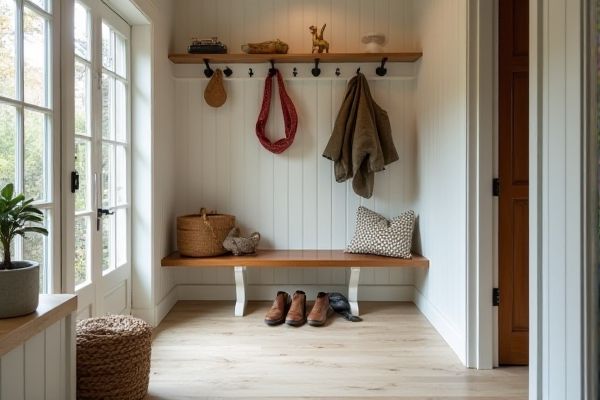
Heated floors in a mudroom provide consistent warmth and comfort, preventing cold, damp surfaces and reducing the risk of slips and moisture damage compared to regular flooring. Discover how choosing heated floors can transform your mudroom experience throughout this article.
Table of Comparison
| Feature | Heated Floor (Mudroom) | Regular Floor (Mudroom) |
|---|---|---|
| Comfort | Provides warmth underfoot, improves comfort during cold months | Cold surface, less comfortable in winter |
| Installation Cost | Higher initial cost due to heating element and thermostat | Lower upfront cost, standard flooring materials |
| Operating Cost | Increased energy usage, moderate to high electricity consumption | No operating cost beyond regular heating |
| Maintenance | Minimal; requires periodic electrical checks | Low; typical floor cleaning and upkeep |
| Installation Complexity | Requires professional installation, electrical work needed | Simple installation, can be DIY |
| Durability | Long-lasting with proper installation, protects floor from moisture damage | Depends on material, may be prone to cold damage or moisture issues |
| Energy Efficiency | Moderate; uses electricity but heats only targeted space | Dependent on room heating, no direct contribution |
| Resale Value | Potentially increases home value with modern features | Neutral impact |
Introduction: Heated Floors vs Regular Floors in Mudrooms
Heated floors in mudrooms provide superior comfort by maintaining a warm surface temperature, reducing cold spots and preventing moisture buildup compared to regular floors. Unlike conventional flooring, heated systems use electric or hydronic methods to evenly distribute heat, improving energy efficiency and enhancing overall user experience. Installation costs are higher for heated floors but offer long-term benefits in energy savings and increased home value.
Understanding Heated Flooring Systems
Heated flooring systems use electric coils or hydronic tubing embedded beneath the floor surface to provide consistent radiant heat, enhancing comfort in mudrooms compared to regular floors. These systems improve energy efficiency by distributing warmth evenly and reducing cold spots common with traditional flooring. Installation complexity and initial costs are higher for heated floors, but the long-term benefits include increased indoor comfort and potential energy savings.
Traditional (Regular) Flooring Overview
Traditional flooring in a mudroom typically consists of materials like ceramic tile, vinyl, or hardwood, which provide durability and ease of cleaning in high-traffic, wet areas. These surfaces do not generate heat, relying on room temperature and insulation for warmth, which can lead to cold, uncomfortable floors during colder months. Selecting the right substrate and moisture barrier is crucial to prevent damage and maintain longevity with regular flooring options in a mudroom.
Installation Process: Heated vs Regular Mudroom Floors
Heated mudroom floors require an installation process involving electric heating mats or hydronic tubing embedded beneath the flooring, which demands precise placement and electrical or plumbing expertise. Regular mudroom floors follow a simpler installation, typically involving subfloor preparation and direct laying of tile, vinyl, or wood, making it faster and more cost-effective. The complexity of heated floor installation increases labor time and materials, but offers long-term comfort and energy efficiency benefits.
Comfort and Warmth: User Experience Comparison
Heated floors in mudrooms provide consistent warmth underfoot, significantly enhancing user comfort during cold seasons compared to regular floors that remain cold and require additional rugs or heaters. The even heat distribution of radiant floor systems prevents cold spots, reducing discomfort and making entry areas more inviting. Regular floors often result in less cozy environments, especially in colder climates, as they lack integrated heating solutions, leading to a less satisfying user experience.
Energy Efficiency and Cost Implications
Heated floors in a mudroom offer improved energy efficiency by providing consistent, radiant warmth that reduces the need for high thermostat settings, leading to lower energy consumption compared to regular floors heated by forced air systems. The upfront installation cost for heated floors is higher, but long-term savings on energy bills can offset this investment, especially in colder climates. Your choice should balance immediate budget constraints against potential utility cost reductions and enhanced comfort.
Maintenance Requirements: Heated vs Regular Floors
Heated floors in a mudroom require periodic inspection of the heating system, including the thermostat and wiring, to ensure efficient operation and prevent malfunctions. Regular floors demand less technical maintenance but may need more frequent cleaning and repairs due to wear and moisture exposure. You can expect heated floors to enhance comfort while requiring slightly more specialized upkeep compared to regular flooring options.
Durability and Longevity in Mudroom Conditions
Heated floors in mudrooms enhance durability by evenly distributing heat, reducing moisture buildup, and preventing cracks caused by freezing and thawing cycles. Regular floors may suffer from moisture damage and warping due to constant exposure to wet and muddy conditions. Investing in heated flooring systems extends the lifespan of mudroom surfaces, minimizing maintenance and repair costs over time.
Design and Material Compatibility
Heated floors in mudrooms require materials with high thermal conductivity, such as ceramic, porcelain tile, or natural stone, to efficiently transfer heat and maintain warmth. Traditional flooring options like hardwood or carpet may insulate heat, reducing the effectiveness of the heating system and increasing energy consumption. Your design choices should prioritize compatibility with underfloor heating to ensure optimal performance and longevity of both the flooring materials and heating components.
Choosing the Best Flooring for Your Mudroom
Heated flooring in your mudroom offers superior comfort and helps prevent cold, damp conditions by evenly distributing warmth, which is especially beneficial in colder climates or during winter months. Regular flooring options, such as tile or vinyl, provide durability and ease of maintenance but may lack the warmth and energy efficiency of radiant heat systems. Choosing the best flooring for your mudroom depends on balancing comfort, insulation needs, and budget while ensuring the material can withstand moisture and heavy foot traffic.
 homyna.com
homyna.com